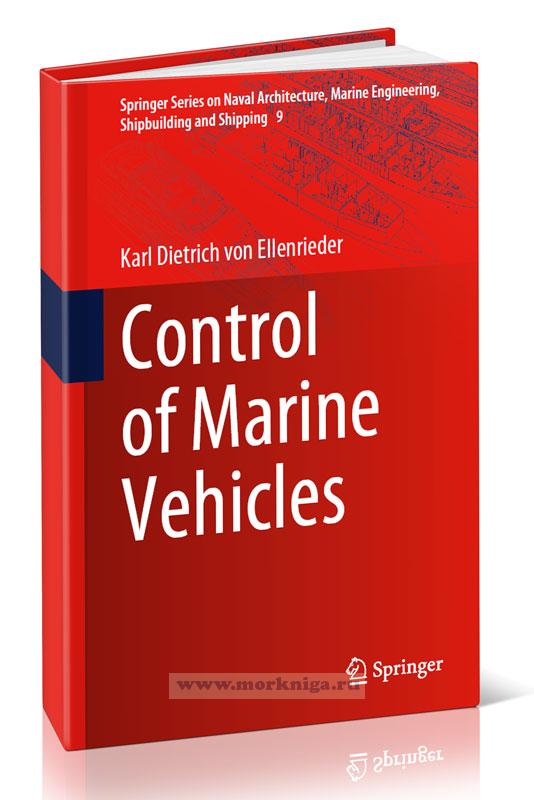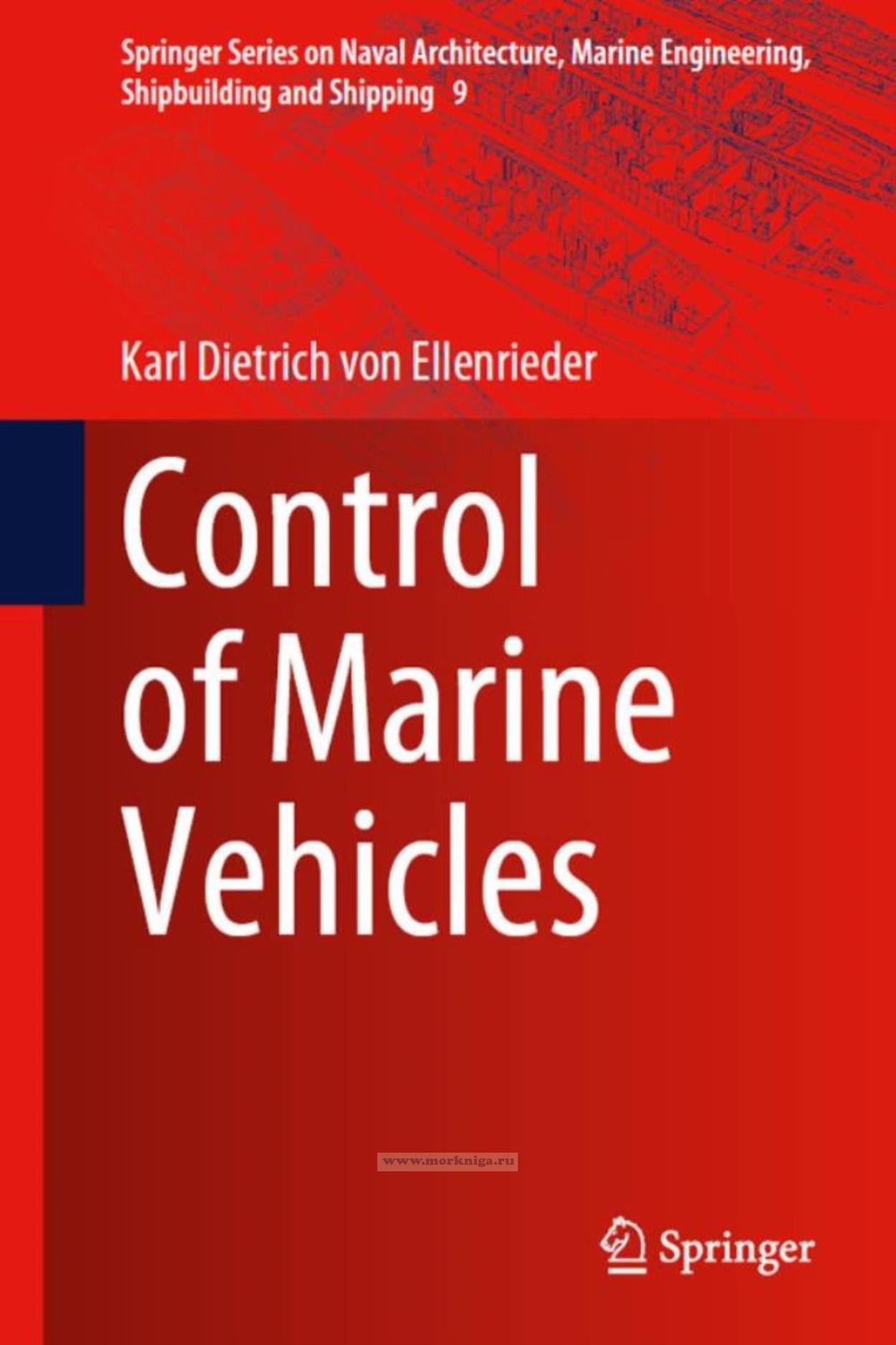Control of Marine Vehicles/Контроль морских транспортных средств
Издание на английском языке
This textbook presents an introduction to the fundamental principles of the control of marine vehicles, at an introductory/intermediate level. The book targets 4th or 5th year undergraduate students, masters students and beginning Ph.D. students and is intended to serve as a bridge across these three academic levels. It will hopefully also be of use to practitioners in the field, who want to review the foundational concepts underpinning some of the recent advanced marine vehicle control techniques found in the literature, which they might find useful for their own applications.
Contents
1 Introduction
1.1 Overview
1.2 Automatic Control
1.3 Background Ideas
1.4 Typical Guidance, Navigation and Control Architectures of Marine Vehicles
1.4.1 Multilayered Software Architectures for Unmanned Vehicles
1.4.2 Inter-Process Communications Methods
1.5 Dynamic Modeling of Marine Vehicles
1.5.1 Kinematics of Marine Vehicles
1.5.2 Kinetics of Marine Vehicles
Problems
References
Part I Linear Methods
2 Stability: Basic Concepts and Linear Stability
2.1 The Stability of Marine Systems
2.2 Basic Concepts in Stability
2.3 Flow Along a Line
2.3.1 Linear 1D Stability Analysis
2.4 Phase Plane Analysis
2.4.1 Linear 2D Stability Analysis
2.4.2 Classification of Linear 2D Systems
2.5 Lyapunov’s Indirect (First) Method
2.6 Stability of Linear Time Invariant Systems
2.6.1 The Laplace Transform
2.6.2 Routh’s Stability Criterion
Problems
References
3 Time Response and Basic Feedback Control
3.1 Dynamic Response
3.1.1 The Impulse Response of 1st and 2nd Order Systems
3.1.2 The Step Response of 2nd Order Systems
3.1.3 Effects of Additional Poles and Zeros
3.2 Block Diagrams
3.3 Feedback Control
3.3.1 Proportional Feedback Control
3.3.2 Derivative Feedback Control
3.3.3 Integral Feedback Control
3.3.4 PID Feedback Control
3.4 Steady State Response
3.5 Additional Performance Measures
Appendix
Problems
References
4 Root Locus Methods
4.1 Introduction
4.2 Root–Locus Diagrams
4.2.1 Constructing a Root–Locus
4.2.2 Properties of the Root Locus
4.3 Root Locus Controller Design Methods
4.3.1 Selecting Gain from the Root Locus
4.3.2 Compensation by Adding or Moving Poles and Zeros
4.3.3 Phase Lag Controllers
4.3.4 Phase Lead Controllers
4.4 General Guidelines for Root Locus Controller Design
4.5 Matlab for Root Locus Analysis and Controller Design
4.5.1 Constructing a Root Locus with Matlab
4.5.2 Use of Matlab for Designing a Phase Lag Controller
4.5.3 Use of Matlab for Designing a Phase Lead Controller
Problems
References
5 Frequency Response Methods
5.1 Frequency Domain Analysis
5.2 The Nyquist Criterion
5.2.1 Nyquist Plots
5.2.2 General Nyquist Criterion
5.2.3 Stability Margins
5.3 Bode Diagrams
5.3.1 Constructing A Bode Diagram
5.4 Assessing Closed Loop Stability from the Bode Diagram
5.4.1 Time Delays
5.5 Dynamic Response from the Bode Diagram
5.5.1 Closed Loop Frequency Response
5.6 Steady-State Response from the Bode Diagram
5.7 Controller Design in the Frequency Domain
5.7.1 Phase Lag Controllers
5.7.2 Phase Lead Controllers
5.7.3 Lead-Lag or PID Controllers
5.7.4 Summary of Compensator Design in the Frequency Domain
5.8 Matlab for Frequency Response Analysis and Control Design
5.8.1 Nyquist Plots
5.8.2 Bode Plots
5.8.3 Matlab for Constructing A PD Controller
Problems
References 6 Linear State Space Control Methods
6.1 Introduction
6.1.1 State Variables
6.2 Reachability/Controllability
6.2.1 Reachable Canonical Form
6.3 State Feedback
6.3.1 Where Do I Place the Poles for State Feedback?
6.3.2 Reachable Canonical Form for State Feedback
6.3.3 Eigenvalue Assignment
6.3.4 State Space Integral Control
6.3.5 Linear Quadratic Regulators
6.4 Observability
6.4.1 Observable Canonical Form
6.5 State Estimation
6.5.1 Where Do I Place the Observer Poles?
6.6 Separation Principle
6.7 Two Degree of Freedom Controllers
6.8 Linear Disturbance Observer Based Control
6.9 Matlab for State Space Controller and Observer Design
Problems
References
Part II Nonlinear Methods
7 Nonlinear Stability for Marine Vehicles
7.1 Introduction
7.2 Stability of Time–Invariant Nonlinear Systems
7.2.1 Stability Definitions
7.2.2 Lyapunov’s Second (Direct) Method
7.3 Invariant Set Theorem
7.4 Stability of Time–Varying Nonlinear Systems
7.5 Input-to-State Stability
7.6 Ultimate Boundedness
7.7 Practical Stability
7.8 Barbalat’s Lemma
7.9 Summary
Problems
References
8 Feedback Linearization
8.1 Introduction
8.2 Inverse Dynamics
8.2.1 Body-Fixed Frame Inverse Dynamics
8.2.2 NED Frame Inverse Dynamics
8.3 Fundamental Concepts in Feedback Linearization
8.3.1 Use of a Linearizing Control Law
8.3.2 Coordinate Transformations for Feedback Linearization
8.4 Structural Properties of Feedback-Linearizable Systems
8.4.1 Manifolds, Lie Derivatives, Lie Brackets and Vector Fields
8.4.2 Frobenius Theorem
8.5 Input-State Linearization
8.6 Input-Output Linearization
8.6.1 Relative Degree
8.6.2 The Normal Form and Zero Dynamics
8.6.3 Stabilization
8.6.4 Tracking
Problems
References
9 Control of Underactuated Marine Vehicles
9.1 Introduction
9.2 The Terminology of Underactuated Vehicles
9.3 Motion Constraints
9.4 The Dynamics of Underactuated Marine Vehicles
9.4.1 The Dynamics of Underactuated Surface Vessels
9.5 Stabilization of Nonholonomic Vehicles
9.5.1 The Controllability of Nonlinear Systems
9.5.2 Stabilization of Nonholonomic Systems
9.5.3 Chained Forms
9.6 Path-Following Control for Surface Vessels
9.6.1 Surge Speed Control
9.6.2 Control of the Cross-Track Error
9.6.3 Waypoint Switching
9.6.4 Other Path Following Approaches
9.7 Trajectory Tracking for Underactuated Surface Vessels
9.7.1 Point-to-Point Motion Planning
9.7.2 Desired Heading and Feedforward Control Inputs
Problems
References
10 Integrator Backstepping and Related Techniques
10.1 Introduction
10.2 Integrator Backstepping
10.2.1 A Simple 2-State SISO System
10.2.2 More General 2-State and 3-State SISO Systems
10.2.3 Generalized n-State SISO Systems: Recursive Backstepping
10.2.4 Vectorial Backstepping for MIMO Systems
10.3 Backstepping for Trajectory Tracking Marine Vehicles
10.3.1 Straight-Forward Backstepping
10.3.2 Passivity-Based Backstepping
10.3.3 Backstepping Implementation Issues
10.4 Augmented Integrator Backstepping
10.5 Dynamic Surface Control
10.5.1 DSC for Trajectory Tracking Marine Vehicles
10.6 Actuator Constraints
10.7 Nonlinear Disturbance Observer Based Control
Problems
References
11 Adaptive Control
11.1 Introduction
11.2 Model Reference Adaptive Control
11.3 Adaptive SISO Control via Feedback Linearization
11.4 Adaptive MIMO Control via Feedback Linearization
Problems
References
12 Sliding Mode Control
12.1 Introduction
12.2 Linear Feedback Control Under the Influence of Disturbances
12.3 First Order SlidingMode Control
12.4 Chattering Mitigation
12.5 Equivalent Control
12.6 Summary of First Order Sliding Mode Control
12.7 Stabilization Versus Tracking
12.8 SISO Super–Twisting Sliding Mode Control
12.9 MIMO Super-Twisting Sliding Modes
12.10 Higher Order Sliding Mode Differentiation
12.11 An HOSMController–Observer
12.12 An HOSM Controller-Observer for Marine Vehicles
Problems
References
Index

